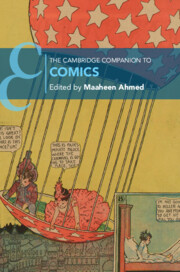Book contents
- The Cambridge Companion to Comics
- The Cambridge Companion to Comics
- Copyright page
- Contents
- Figures
- Contributors
- Acknowledgments
- Chronology
- Introduction
- Part I Forms
- Part II Readings
- Part III Uses
- Chapter 13 Comics and Their Archives
- Chapter 14 Readers and Fans
- Chapter 15 Comics in the Museum
- Chapter 16 Comics in Libraries
- Chapter 17 “Educationally Occupied”
- Further Reading
- Index
- Cambridge Companions To …
- References
Chapter 14 - Readers and Fans
Lived Comics Cultures
from Part III - Uses
Published online by Cambridge University Press: 17 August 2023
- The Cambridge Companion to Comics
- The Cambridge Companion to Comics
- Copyright page
- Contents
- Figures
- Contributors
- Acknowledgments
- Chronology
- Introduction
- Part I Forms
- Part II Readings
- Part III Uses
- Chapter 13 Comics and Their Archives
- Chapter 14 Readers and Fans
- Chapter 15 Comics in the Museum
- Chapter 16 Comics in Libraries
- Chapter 17 “Educationally Occupied”
- Further Reading
- Index
- Cambridge Companions To …
- References
Summary
This chapter explores some of the practices, interactions, and preferences of readers and fans as part of their lived comics cultures. Engagement with the medium has taken various forms, from casual readership and sharing titles among friendship groups in childhood, through to being a collector. Beyond simply involving reading comics, fandom can incorporate a range of other activities as part of an enhanced commitment to the medium, and various activities are touched upon. Further, it looks at how readers, both historically and today, have accessed their comics in varied formats and across many genres in Britain and the USA, linking their lived experience with production. In looking into these issues, the chapter engages with the work of various publishers, genres, and titles. It also engages with how reading comics and participating in fandom intersects with both age and gender, which this chapter adopts as lenses to look at constructions of childhood and comics reading. A final aspect of the chapter relates to how fan and reader interactions in these spaces and participation in activities often vary according to gender. Indeed, it can be argued that comics reading and collecting has been heavily gendered regarding both production and reception.
- Type
- Chapter
- Information
- The Cambridge Companion to Comics , pp. 287 - 307Publisher: Cambridge University PressPrint publication year: 2023

